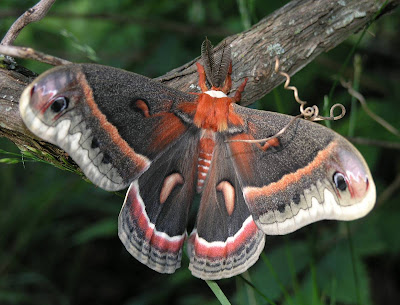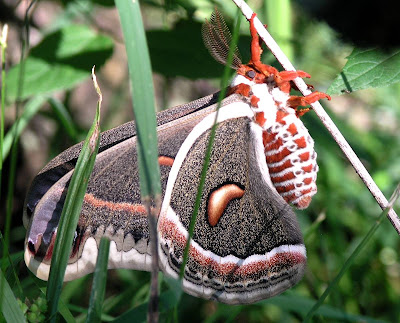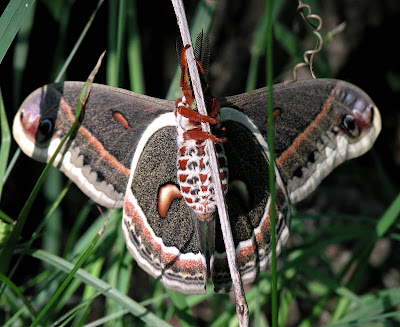
Cecropia Moth (Hyalophora cecropia)
With it's bright colors and nearly six inch wingspan, this Cecropia Moth was one of those make-your-day finds for Jo and I. (Jo gets the credit for both the find and the photos.) It is the largest moth native to the United States. Judging by it's nearly pristine condition and the fact it was very tolerant of our taking photos, I'd say this this Giant Silkworm Moth had recently emerged from it's cocoon. (There's a word for that, but it escapes me.) Over the winter we'd seen a Cecropia Moth cocoon up in the tree above where this moth was found, but at the time we didn't know what it was.
Jo found the moth at the base of the tree an hour or so before sunset. It stayed in that location for forty-five minutes or so before finally taking flight. When it finally did fly, it could have easily been mistaken for a bat.
Like all Giant Silkworm Moths, Cecropia has a brief lifespan as an adult moth -- only a matter of days. It does not feed, but only finds a mate, breeds, lays eggs if a female and dies.
I've identified this moth as a male because of its large, full and feathery antennae. Females emit pheromones to aid males in finding them. Males "smell" these pheromones via receptors on their antennae. Therefore, males have evolved larger antennae to heighten their sense of smell. (A photo of a female Cecropia is here for comparison.)

Species details from Butterflies and Moths of North America:
Family: Wild Silk Moths (Saturniidae)
Subfamily: Giant Silkworm Moths (Saturniinae)
Identification: Body is red with a white collar and white bands on the abdomen. Wings are dark brown with white hairlike scales giving a frosted appearance; forewings are red at the base. Crescent spots and the area outside the postmedian line are red on all wings.
Life history: Females lay rows of 2-6 eggs on both sides of the leaves of small host trees or shrubs. Eggs hatch in 10-14 days. Young caterpillars feed in groups on leaves; older caterpillars are solitary. The cocoon is attached along its full length to a twig; to escape predation by rodents and birds, the cocoon is usually constructed in a dark, protected area.
Flight: One flight from March-July in most of the range; two flights in the Midwest, from May-early June and then 2 weeks later.
Wing span: 4 5/16 - 5 7/8 inches (11 - 15 cm).
Caterpillar hosts: Various trees and shrubs including box elder (Acer negundo), sugar maple (Acer saccharinum), wild cherries and plums (Prunus), apples (Malus), alder and birch (Betulaceae), dogwoods (Cornus), and willows (Salix).
Adult food: Adults do not feed.
Habitat: Successional habitats in many areas including urban and suburban environments.
Range: Nova Scotia and Maine south to Florida; west across southern Canada and the eastern United States to the Rocky Mountains.

On a more somber note, the population of Cecropia and other giant silkworm moths is in decline in the United States, especially in the northeast. The story begins around 1869 when an amateur entomologist attempting to breed better silkworms accidentally released gypsy moths he'd imported from Europe. By the turn of the century, gypsy moths were running rampant and deforesting large areas of the northeast. In response, various agencies imported from Europe and released large quantities of the parasitic fly Compsilura concinnata. The fly no doubt parasitized and destroyed an untold number of gypsy moth larva, but unfortunately, it is not species specific and is the prime suspect in the decline of various moths. In one study, researchers from the University of Massachusetts baited a tree with silkworm moth caterpillars. Over 80% were destroyed by Compsilura maggots.
Sources and links:
When Biocontrols Get Out of Control (NY Times)
The Silkmoth and the Fly (UMass Magazine)
BugGuide Species Page



24 comments:
Marvin,
You have outdone yourself.
Fantastic photographs and really great information. I have never seen one in this pristine condition.
Photographed in as near to perfect setting and colors as possible.
Fantastically sharp.
Well done,
Troy
Lovely photograph. I found a giant promethea moth last year and its wings were huge. I would say they were at least 6 inches wide or wider. I have photos of it but don't know how to show them to you unless I post them.
amazing butterfly. wonderful colors and interesting info
Excellent post... and what a cracker of a moth this is... I'd love to have seen it up close and personal.. it would have made my day to.
Marvin - the story of Compsilura and our native royal moths is sobering. This parasitoid is an extreme generalist, attacking over 200 different host species. Similar rates of parasitism as those you cite for cecropia moth have also been reported for luna moth, promethea moth, and a threatened species of buck moth. In all cases, it was the dominant parasitoid reared from caterpillars of these species, superimposing an extraordinary mortality factor on top of the already existing native ones. The introduction of this species for gypsy moth control really provides a cautionary tale for future biocontrol releases of non-native parasitoids.
These moths are just so pretty they seem unreal. They are so big it makes me want to pet them like a cat.
Thanks to everyone for their visits and comments.
Ted: I appreciate the additional information. With examples like this, it's hard to believe that biocontrols is still -- for all practical purposes -- a totally unregulated industry. That's why Japanese Lady Beetles are still being sold and released even though they're replacing native species.
Abraham: Last summer I photographed a large Polyphemus Moth out on the porch. I thought it was beautiful. On my next trip out, all that remained was a couple of wings. The phoebe nesting nearby evidently thought the Polyphemus was delicious.
If you want to contact me or send photos, there is an image displaying an email address on the blog sidebar. It is:
natureDOTmarvinATgmailDOTcom
Sending photos is fine -- just please remember that I'm connected to the Net via a tin can and string. It's up to you whether you want to go that route or not.
Lovely & fascinating. Growing up in NY, I remember the devastation done by gypsy moths--it was depressing to see. If only we could take that idiot & the idiots who bred killer bees & punish them all HARSHLY for not leaving nature well enough ALONE!
Wow. Gorgeous photos. Don't you wonder how he can fly with such a chunky body?
I always love finding these guys! Bravo photos!
Oh, gosh, what a beautiful creature! Thanks, Jo, for having such a sharp eye! Interesting information, also.
Oh, gosh, what a beautiful creature! Thanks, Jo, for having such a sharp eye! Interesting information, also.
Fantastic butterfly photos! great info as well, thanks for sharing it.
Marvin, this is an excellent post and so informative! I didn't know half this stuff. I had only heard of this moth from a movie called "Girl of the Limberlost". I had no idea it was so huge! What a life to emerge from your cacoon only to mate and die! I lived in the Northeast and saw the destruction by gypsy moths. I despise them! How sad to see the tragedy brought on by human interference.
Dear Marvin,
Wow!!! made my day seeing your fantastic photos...If I ever see one in my backyard I do think you will hear my shouts of joy all the way down to your house.
Incredible.
Sherry
Marvin,
While my boyfriend and I were golfing we found the Cecropia moth while it was still a caterpiller and it is about 4 1/2 inches long, we were so excited so we brought it home for everyone to see they were so amazed at what it looked like and how big it was. I found your website because i was tring to figure out what it was. Thanks it helps a lot...
Just today I was walking to the bus for school and I found a HUGE beautiful moth on the ground. The biggest moth I've ever seen! It was lying on its side, I gently nudged it to see if it was alive. It struggled to move and looked as though it was in pain. Very gently I picked it up and took it inside. Thinking it was going to die I put it in a safe dry container lined with tissues. Came home today, its still alive. Just found out what kind of moth it is now, thanks to this site.
It is a male Cecropia Moth, with a full 4 1/2 inch wing span. This morning he had some stuff coming out his end, thought it was guts or something like some moths do when near death, but its gone now. He is certainly doing much better because he is moving around more. Very scared though, shaking wings.
I don't know what to do, I would shurely like to keep him for his beautiful wings. But I realize the declining of this specific moth. He only has a few more days though.
But what should I do?
I guess I just feel lucky enough to have seen one in person, let alone hold one, that I certainly won't forget.
i have one right now it is so huge it is like from wing tip to wing tip is like 5 inches its body is the size of my thumb
hello my name is justin i just recently saved on from a bird and i went on the internet and i did not know what this was until now he has one full wing and the other is about half gone im trying to nurse him back i found out what kind it was i have pics and videos my email is gpadio007@yahoo.com
I have one on my screen door right now. It is 8:25 EST in Holden MA. The thing is gigantic. I will post a photo if I can.
One of our custodians found a moth this morning and brought it to school.She wanted the children to see it. Mrs. Iaconelli and I began an internet search and found that it is the silkworm moth. WOW!
Thank you for your great pictures that really aided us in the search. Our location is Atlantic City New Jersey.
I found one of these today in Reno, NV. Its so beautiful I had no idea what it was. The picture I took looks very similiar to the one you have here. So beautiful and what a great experience.
If you would like to see mine I can send to you. My email is tabbieh@yahoo.com.
Thank you for sharing =)
Hello,
I stumbled upon one this morning chillin' on my porch. I live in Northwest Ohio. I think it is male compared to photos...An absolutely beautiful creature! I hope he isn't dying he's been on our porch since this morning and still hasen't taken flight...He tolerated many pictures and a wing measurement of six inches...he is massive!
Thanks to everyone for your recent comments. I've been mostly on the road for the past month or so and then suffered computer problems once back home. I haven't even been able to keep up with moderating blog comments, much less replying to them. My apologies for that.
I'm glad my photos and post were a help to you in identifying and learning more about the Cecropia Moths you found.
Post a Comment